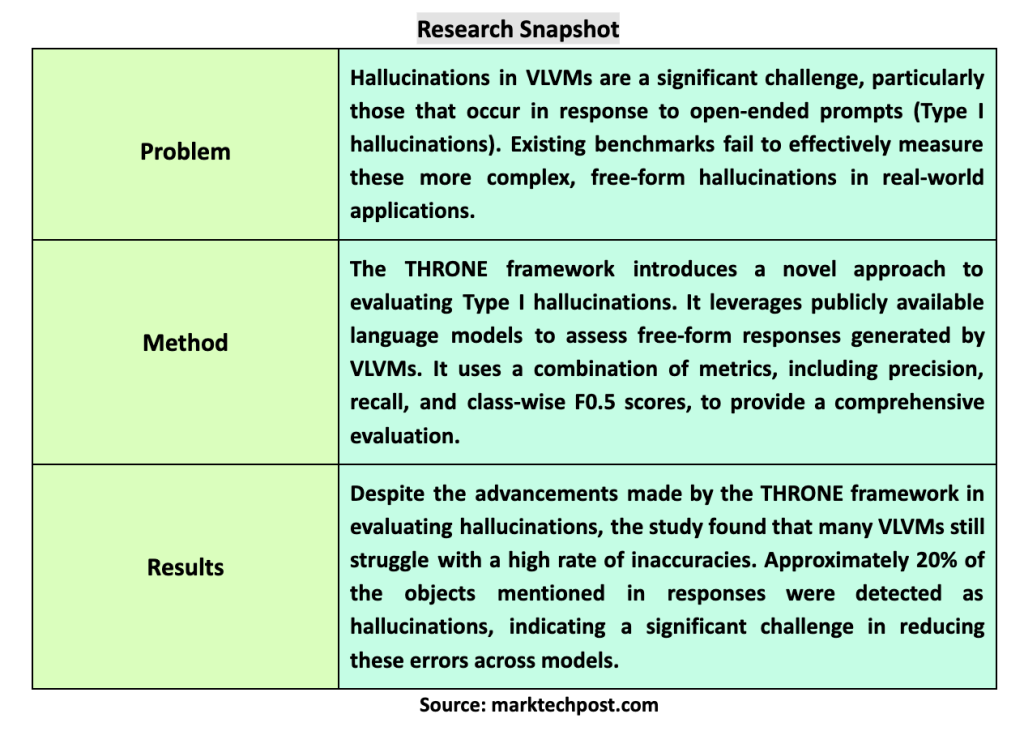Understanding and mitigating hallucinations in vision and language models (VLVM) is an emerging field of research that addresses the generation of coherent but objectively incorrect responses by these advanced ai systems. As VLVMs increasingly integrate text and visual inputs to generate responses, the accuracy of these outputs becomes crucial, especially in environments where accuracy is paramount, such as medical diagnostics or autonomous driving.
Hallucinations in VLVMs generally manifest as plausible but incorrect details generated about an image. These inaccuracies pose significant risks and potentially misinform decisions in critical applications. The challenge lies in detecting these errors and developing methods to effectively mitigate them, ensuring the reliability of VLVM outputs.
Most existing benchmarks for assessing hallucinations in VLVM focus on responses to restricted query formats, such as yes/no questions about specific objects or attributes within an image. These benchmarks often fail to measure more complex and open-ended hallucinations that can occur in various real-world applications. As a result, there is a significant gap in the ability to fully understand and mitigate the broader spectrum of hallucinations that VLVMs can produce.
Researchers at the University of Oxford, AWS ai Labs, introduced a new framework called THRONE (Recognition of text hallucinations from images with object probes for open evaluation) to address this gap. THRONE is designed to evaluate type I hallucinations, those that occur in response to overt prompts that require detailed descriptions of the images. Unlike previous methods, THRONE uses publicly available language models to evaluate hallucinations in free-form responses generated by various VLVMs, offering a more comprehensive and rigorous approach.
THRONE leverages multiple metrics to quantitatively measure hallucinations in different VLVMs. For example, it employs precision and recall metrics along with an F0.5 score per class, which emphasizes precision twice as much as recall. This score is particularly relevant in scenarios where false positives, incorrect but plausible answers, are more harmful than false negatives.
An evaluation of the effectiveness of THRONE revealed insightful data on the prevalence and characteristics of hallucinations in current VLVMs. Despite the advanced approach of the framework, the results indicate that many VLVMs still struggle with a high rate of hallucinations. For example, the framework detected that some of the models evaluated produce responses, with around 20% of the objects mentioned being hallucinations. This high rate of inaccuracies underscores the persistent challenge of reducing hallucinations and improving the reliability of VLVM results.

In conclusion, the THRONE framework represents an important step forward in the evaluation of hallucinations in vision-language models, addressing in particular the complex issue of type I hallucinations in free-form responses. While existing benchmarks have struggled to effectively measure these more nuanced errors, THRONE uses a novel combination of publicly available language models and a robust metric system, including precision, recall, and F0.5 scores per class. Despite these advances, the high rate of detected hallucinations, around 20% in some models, underlines the current challenges and the need for further research to improve the accuracy and reliability of VLVMs in practical applications.
Review the Paper. All credit for this research goes to the researchers of this project. Also, don't forget to follow us on twitter.com/Marktechpost”>twitter. Join our Telegram channel, Discord channeland LinkedIn Grabove.
If you like our work, you will love our Newsletter..
Don't forget to join our 42k+ ML SubReddit
![]()
Sana Hassan, a consulting intern at Marktechpost and a dual degree student at IIT Madras, is passionate about applying technology and artificial intelligence to address real-world challenges. With a strong interest in solving practical problems, she brings a new perspective to the intersection of ai and real-life solutions.
(Recommended Reading) GCX by Rightsify: Your go-to source for high-quality, ethically sourced, copyright-cleared ai music training datasets with rich metadata
<script async src="//platform.twitter.com/widgets.js” charset=”utf-8″>
 NEWSLETTER
NEWSLETTER





